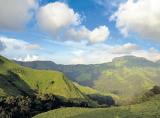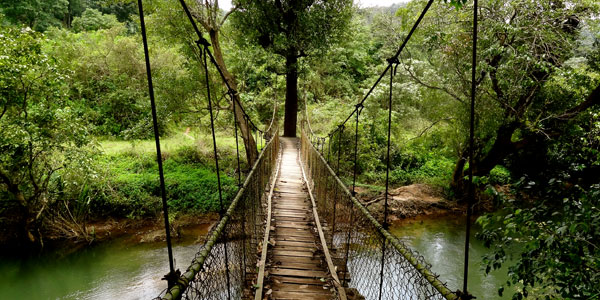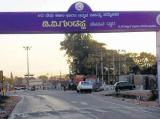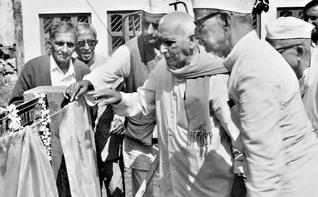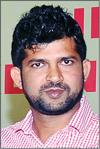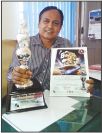Nestled in the verdant landscape of hills and forests, Kodagu is considered as one of the most beautiful hill stations in Karnataka. Popular for its serene nature, rich biodiversity, quality coffee, vibrant culture and brave warriors, the district has made great strides in tourism and agriculture. Located in the Western Ghats mountain range, Kodagu has many places of tourist interest. During the monsoons, nature is at its best here with spectacular sights of rivers and waterfalls. Trekking, water sports and nature-watching are some of the common activities people get indulged in while farmers get busy in agricultural activities. Here is a glimpse into the diversity of Kodagu in the rainy season.
The charm of water
The Brahmagiri hill range in the western and southern parts of Kodagu has some of the highest peaks of Karnataka such as Thadiyandamol. Near Thadiyandamol, and on the way west from the town of Virajpet (about 16 km away) towards Talacauvery, is a beautiful natural cascade called the Chelavara Falls beside the village of Cheyyandane. This waterfall is within a forest and is part of a stream, which eventually joins River Cauvery. Chelavara is also called Embepare or Tortoise rock colloquially. There is a beautiful hill called Choma Kund, a couple of kilometres away. Chelavara is accessible from Madikeri and Virajpet by road.
River Lakshmanathirtha takes birth in the forests of Western Ghats and flows through Kodagu and Mysuru until it merges with River Cauvery at the Krishna Raja Sagara (KRS) in Mandya. Near Kurchi village in South Kodagu, this tributary cascades down a rocky hill, forming a waterfall. The waterfall is called as Irupu Falls. Legend has it that Rama, Lakshmana and Hanuman had come to this place and when Rama was thirsty, Lakshmana shot an arrow into the hills and hence, River Lakshmanathirtha was born. There is one more version of the story, which says that Lakshmana had once unwittingly insulted Rama and later, tried to immolate himself in repentance. In order to douse the fire and save Lakshmana, Rama shot an arrow into the rocks and the stream was formed. A Shiva linga was installed by Rama to aid his prayers. Nearby is the Hanuman Betta. One will be pointed out to a crescent shaped depression on that hill and told that it was formed when the powerful Hanuman wound his large tail around it in an attempt to heave it. The Irupu Falls can be reached by road from the towns of Virajpet or Gonikoppal. The best time to visit the falls is monsoon.
River Barapole near T Shettigeri is accessible from Virajpet and is a good site for white water rafting. It has a number of rapids with strange sounding names such as Grasshopper, Morning Coffee, Wicked Witch, Frame Head and Milky Churn. The river takes birth in the Brahmagiri hills, meanders through forests and coffee plantations and then disappears into the Brahmagiri Wildlife Sanctuary. The greenery on either side is infested with reptiles and insects, so the traveller needs to take precautions. The rivulet eventually goes west into Kerala and descends into the Arabian Sea.
Nishani Motte is a lesser-known peak near the temple town of Bhagamandala which is known for Triveni Sangam, a confluence of three rivers. Nishani motte is a good place for trekkers but one must seek permission from the Forest Department and follow a ‘leave no trace’ policy in order to safeguard the ecology of the area. A part of the trail has to be taken by jeep. If one is lucky, then he or she can spot elephants grazing below the hills. One also needs to watch out for leeches.
The rain god
The Padi Igguthappa Temple dedicated to Igguthappa, considered as the god of rains, is located near the town of Kakkabe in the Thadiyandamol region and is accessible by road. In Kodagu, Igguthappa is venerated as a hero god and especially remembered during Puttari, the harvest festival. While River Cauvery is called the kula devi or patron goddess, Igguthappa is known as mahaguru, or chief preceptor. He is also considered as the giver of food. It is one of the most ancient temples in Kodagu.
The main annual temple festival of Padi Igguthappa happens around April. The date of Puttari festival is decided in the Igguthappa temple. The festival begins in the temple and the crop is first offered here. Only then the people of Kodagu celebrate the festival. During the harvest festival, people invoke Igguthappa, Mahadeva and Baithurappa (the deity of Vayathur).
According to a ballad, Igguthappa had five brothers and a sister, and all were reincarnations of various deities. Born across the celestial milky ocean, they arrived as children in the northern Malabar coast.While three elder brothers settled in different places of worship as deities, the remaining four siblings crossed the Western Ghats and entered Kodagu. Led by Igguthappa, the eldest among them, they came near a hill in the village of Kakkabe. There, they felt hungry and hence came to a halt. They were in the family property of Nambimada Muthanna, a local farmer and landlord. Later, Muthanna had the Padi Igguthappa Temple built. His descendants became the hereditary managers of that temple. Though the temple’s history dates back to several centuries, the present temple is said to be built by a king a couple of centuries ago.
Among the younger brothers of Igguthappa, one was an avatar of Lord Mahalingeshwara. He settled down in the village of Palur along River Cauvery and came to be known as Palurappa. Pemmayya, the last of the brothers went southward dressed as a yogi. He crossed the Brahmagiri hill range and settled down in Thirunelli, Wayanad. His temple came to be known as Janardhana Temple, named after the deity whose avatar he was. The sister came to be known as Ponnangalatamme as she was destined to settle in Ponnangala in Yavakapadi village.
During the monsoons, races called the naati ota are organised upon the paddy fields of Kodagu. A long strip of land in a paddy field is left uncultivated. Both sides of this strip have three parallel rows of paddy seedlings, called naati. These rows are also called darae naati as they show the way to the runners. The track is set in the night. It is usually the farmers themselves who get together and organise the ota, or race. Traditionally, the runners gather from the neighbouring villages. They race across the track and through the slush, stumbling along the way. The winners are given a prize money. After the race, the track will have seedlings planted in them.
The event attracts large numbers of people from villages and towns. Be it rural sports rooted in culture or historical temples or serene places, Kodagu has something for everyone.
source: http://www.deccanherald.com / Deccan Herald / Home> Supplements> Spectrum / by Mookonda Kushalappa / August 02nd, 2016
